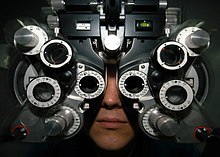This article needs additional citations for verification. (May 2016) |


A phoropter or refractor is an ophthalmic testing device. It is commonly used by eye care professionals during an eye examination, and contains different lenses used for refraction of the eye during sight testing, to measure an individual's refractive error and determine their eyeglass prescription. [1] It also is used to measure the patients' phorias and ductions, which are characteristics of binocularity.
Typically, the patient sits behind the phoropter, and looks through it at an eye chart placed at optical infinity (20 feet or 6 metres), then at near (16 inches or 40 centimetres) for individuals needing reading glasses. The eye care professional then changes lenses and other settings, while asking the patient for subjective feedback on which settings gave the best vision. The patient's habitual prescription or an automated refractor may be used to provide initial settings for the phoropter. Sometimes a retinoscope is used through the phoropter to measure the vision without the patient having to speak, which is useful for infants and people who do not speak the language of the practitioner.
Phoropters can also measure heterophorias (natural resting position of the eyes), accommodative amplitudes, accommodative leads/lags, accommodative posture, horizontal and vertical vergences, and more.

The major components of the phoropter are the battery of spherical and cylindrical lenses, auxiliary devices such as Maddox rods, filtered lenses, prisms, and the JCC (Jackson cross cylinder) used for astigmatism measurement. The prismatic lenses are used to analyze binocular vision and treat orthoptic problems.
From the measurements taken, the specialist will write an eyeglass prescription that contains at least three numerical specifications for each eye: sphere, cylinder, and axis, as well as pupillary distance (distance between eyes), and, rarely, prism for one or both eyes.
The lenses within a phoropter refract light in order to focus images on the patient's retina. The optical power of these lenses is measured in 0.25 diopter increments. By changing these lenses, the examiner is able to determine the spherical power, cylindrical power, and cylindrical axis necessary to correct a person's refractive error. The presence of cylindrical power indicates the presence of astigmatism, which has an axis measured from 0 to 180 degrees away from being aligned horizontally.
Phoropters are made with either plus or minus cylinders. Traditionally, ophthalmologists and orthoptists use plus cylinder phoropters and optometrists use minus cylinder phoropters. One can mathematically convert figures obtained from either type of phoropter to the other.
- ^ Dictionary.com, Definition of "phoropter", American Heritage Stedman's Medical Dictionary. Retrieved 10-10-10.